Sticky Postings
All 242 fabric | rblg updated tags | #fabric|ch #wandering #reading
By fabric | ch
-----
As we continue to lack a decent search engine on this blog and as we don't use a "tag cloud" ... This post could help navigate through the updated content on | rblg (as of 09.2023), via all its tags!
FIND BELOW ALL THE TAGS THAT CAN BE USED TO NAVIGATE IN THE CONTENTS OF | RBLG BLOG:
(to be seen just below if you're navigating on the blog's html pages or here for rss readers)
--
Note that we had to hit the "pause" button on our reblogging activities a while ago (mainly because we ran out of time, but also because we received complaints from a major image stock company about some images that were displayed on | rblg, an activity that we felt was still "fair use" - we've never made any money or advertised on this site).
Nevertheless, we continue to publish from time to time information on the activities of fabric | ch, or content directly related to its work (documentation).
Monday, June 19. 2017
Sucking carbon from the air | #device #environment
Note: the following post has been widely reblogged recently. The reason why I did wait a bit before archiving it in | rblg.
It interests me as a king of "device" that can handle environmental parameters. In this sense, it has undoubtedly architectural characteristics and could extend itself into an "architectural device". Think here for exemple about the ongoing Jade Eco Park by Philippe Rahm architectes, filled with devices in the competition proposal. Or to move less further about our own work, with small "environmental devices" like Perpetual (Tropical) SUNSHINE, Satellite Daylight, etc. Architecture as device like Public Platform of Future Past, I-Weather as Deep Space Public Lighting or Heterochrony, or even data tools like Deterritorialized Living.
As a matter of fact, there is a "devices" tag in this blog for this precise reason, to give references for trhese king of architectures that trigger modification in the environment.
Via Science
-----
In Switzerland, a giant new machine is sucking carbon directly from the air



The world's first commercial plant for capturing carbon dioxide directly from the air opened yesterday, refueling a debate about whether the technology can truly play a significant role in removing greenhouse gases already in the atmosphere. The Climeworks AG facility near Zurich becomes the first ever to capture CO2 at industrial scale from air and sell it directly to a buyer.
Developers say the plant will capture about 900 tons of CO2 annually — or the approximate level released from 200 cars — and pipe the gas to help grow vegetables.
While the amount of CO2 is a small fraction of what firms and climate advocates hope to trap at large fossil fuel plants, Climeworks says its venture is a first step in their goal to capture 1 percent of the world's global CO2 emissions with similar technology. To do so, there would need to be about 250,000 similar plants, the company says.

"Highly scalable negative emission technologies are crucial if we are to stay below the 2-degree target [for global temperature rise] of the international community," said Christoph Gebald, co-founder and managing director of Climeworks. The plant sits on top of a waste heat recovery facility that powers the process. Fans push air through a filter system that collects CO2. When the filter is saturated, CO2 is separated at temperatures above 100 degrees Celsius.
The gas is then sent through an underground pipeline to a greenhouse operated by Gebrüder Meier Primanatura AG to help grow vegetables, like tomatoes and cucumbers.
Gebald and Climeworks co-founder Jan Wurzbacher said the CO2 could have a variety of other uses, such as carbonating beverages. They established Climeworks in 2009 after working on air capture during postgraduate studies in Zurich.
The new plant is intended to run as a three-year demonstration project, they said. In the next year, the company said it plans to launch additional commercial ventures, including some that would bury gas underground to achieve negative emissions.
"With the energy and economic data from the plant, we can make reliable calculations for other, larger projects," said Wurzbacher.
Note: with interesting critical comments below concerning the real sustainable effect by Howard Herzog (MIT).
'Sideshow'
There are many critics of air capture technology who say it would be much cheaper to perfect carbon capture directly at fossil fuel plants and keep CO2 out of the air in the first place. Among the skeptics are Massachusetts Institute of Technology senior research engineer Howard Herzog, who called it a "sideshow" during a Washington event earlier this year. He estimated that total system costs for air capture could be as much as $1,000 per ton of CO2, or about 10 times the cost of carbon removal at a fossil fuel plant.
"At that price, it is ridiculous to think about right now. We have so many other ways to do it that are so much cheaper," Herzog said. He did not comment specifically on Climeworks but noted that the cost for air capture is high partly because CO2 is diffuse in the air, while it is more concentrated in the stream from a fossil fuel plant. Climeworks did not immediately release detailed information on its costs but said in a statement that the Swiss Federal Office of Energy would assist in financing. The European Union also provided funding.
In 2015, the National Academies of Sciences, Engineering and Medicine released a report saying climate intervention technologies like air capture were not a substitute for reducing emissions. Last year, two European scientists wrote in the journal Science that air capture and other "negative emissions" technologies are an "unjust gamble," distracting the world from viable climate solutions (Greenwire, Oct. 14, 2016).
Engineers have been toying with the technology for years, and many say it is a needed option to keep temperatures to controllable levels. It's just a matter of lowering costs, supporters say. More than a decade ago, entrepreneur Richard Branson launched the Virgin Earth Challenge and offered $25 million to the builder of a viable air capture design.
Climeworks was a finalist in that competition, as were companies like Carbon Engineering, which is backed by Microsoft Corp. co-founder Bill Gates and is testing air capture at a pilot plant in British Columbia.
-----
...
And let's also mention while we are here the similar device ("smog removal" for China cities) made by Studio Roosegaarde, Smog Free Project.
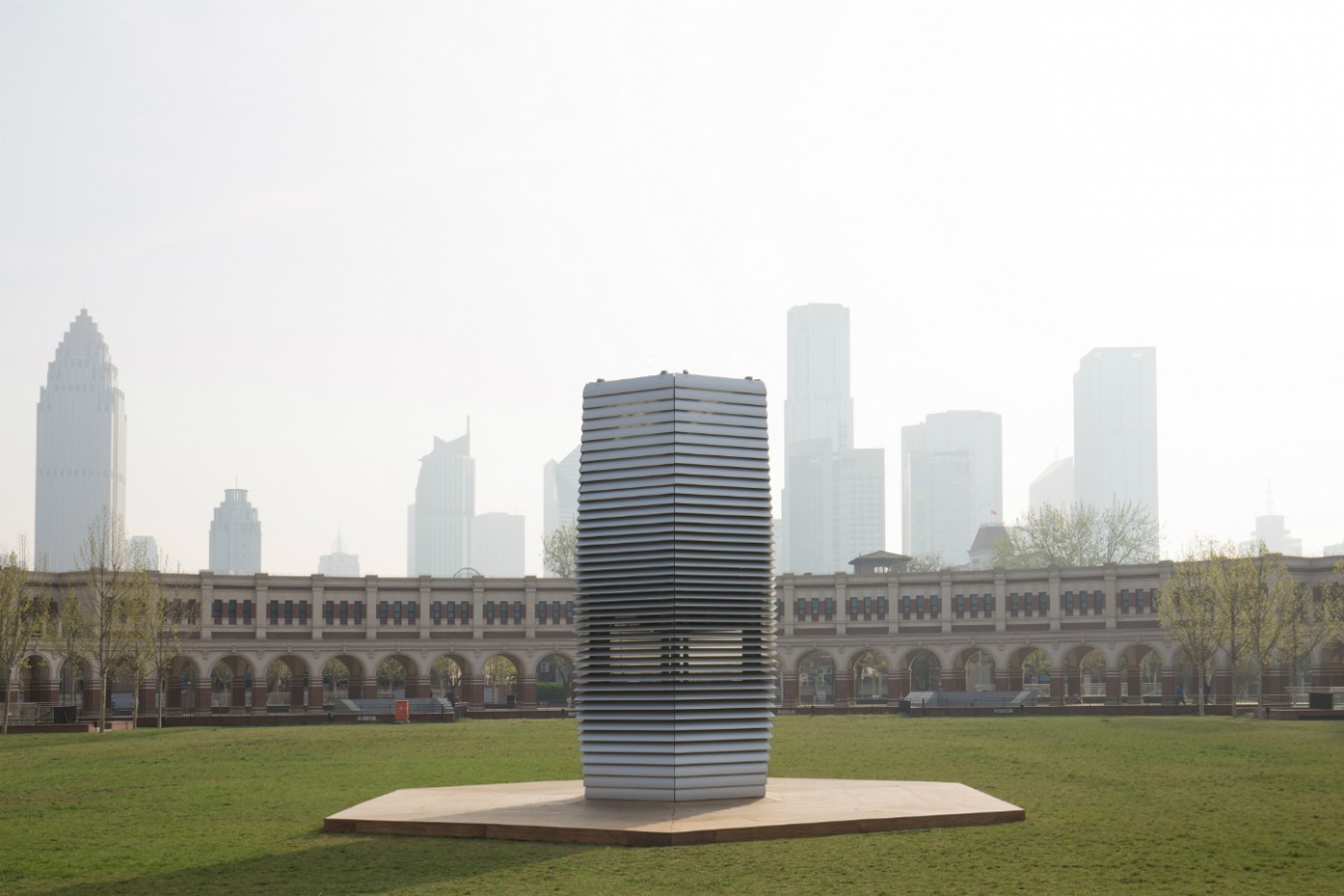
Related Links:
Tuesday, December 23. 2014
Can Sucking CO2 Out of the Atmosphere Really Work? | #atmosphere
-----
A Columbia scientist and his startup think they have a plan to save the world. Now they have to convince the rest of us.
By Eli Kintish

CTO and co-founder Peter Eisenberger in front of Global Thermostat’s air-capturing machine.
Physicist Peter Eisenberger had expected colleagues to react to his idea with skepticism. He was claiming, after all, to have invented a machine that could clean the atmosphere of its excess carbon dioxide, making the gas into fuel or storing it underground. And the Columbia University scientist was aware that naming his two-year-old startup Global Thermostat hadn’t exactly been an exercise in humility.
But the reception in the spring of 2009 had been even more dismissive than he had expected. First, he spoke to a special committee convened by the American Physical Society to review possible ways of reducing carbon dioxide in the atmosphere through so-called air capture, which means, essentially, scrubbing it from the sky. They listened politely to his presentation but barely asked any questions. A few weeks later he spoke at the U.S. Department of Energy’s National Energy Technology Laboratory in West Virginia to a similarly skeptical audience. Eisenberger explained that his lab’s research involves chemicals called amines that are already used to capture concentrated carbon dioxide emitted from fossil-fuel power plants. This same amine-based technology, he said, also showed potential for the far more difficult and ambitious task of capturing the gas from the open air, where carbon dioxide is found at concentrations of 400 parts per million. That’s up to 300 times more diffuse than in power plant smokestacks. But Eisenberger argued that he had a simple design for achieving the feat in a cost-effective way, in part because of the way he would recycle the amines. “That didn’t even register,” he recalls. “I felt a lot of people were pissing on me.”
The next day, however, a manager from the lab called him excitedly. The DOE scientists had realized that amine samples sitting around the lab had been bonding with carbon dioxide at room temperature—a fact they hadn’t much appreciated until then. It meant that Eisenberger’s approach to air capture was at least “feasible,” says one of the DOE lab’s chemists, Mac Gray.
Five years later, Eisenberger’s company has raised $24 million in investments, built a working demonstration plant, and struck deals to supply at least one customer with carbon dioxide harvested from the sky. But the next challenge is proving that the technology could have a transformative impact on the world, befitting his company’s name.
The need for a carbon-sucking machine is easy to see. Most technologies for mitigating carbon dioxide work only where the gas is emitted in large concentrations, as in power plants. But air-capture machines, installed anywhere on earth, could deal with the 52 percent of carbon-dioxide emissions that are caused by distributed, smaller sources like cars, farms, and homes. Secondly, air capture, if it ever becomes practical, could gradually reduce the concentration of carbon dioxide in the atmosphere. As emissions have accelerated—they’re now rising at 2 percent per year, twice as rapidly as they did in the last three decades of the 20th century—scientists have begun to recognize the urgency of achieving so-called “negative emissions.”
The obvious need for the technology has enticed several other efforts to come up with various approaches that might be practical. For example, Climate Engineering, based in Calgary, captures carbon using a liquid solution of sodium hydroxide, a well-established industrial technique. A firm cofounded by an early pioneer of the idea, Eisenberg’s Columbia colleague Klaus Lackner, worked on the problem for several years before giving up in 2012.
“Negative emissions are definitely needed to restore the atmosphere given that we’re going to far exceed any safe limit for CO2, if there is one. The question in my mind is, can it be done in an economical way?”
A report released in April by the Intergovernmental Panel on Climate Change says that avoiding the internationally agreed upon goal of 2 °C of global warming will likely require the global deployment of “carbon dioxide removal” strategies like air capture. (See “The Cost of Limiting Climate Change Could Double without Carbon Capture Technology.”) “Negative emissions are definitely needed to restore the atmosphere given that we’re going to far exceed any safe limit for CO2, if there is one,” says Daniel Schrag, director of the Harvard University Center for the Environment. “The question in my mind is, can it be done in an economical way?”
Most experts are skeptical. (See “What Carbon Capture Can’t Do.”) A 2011 report by the American Physical Society identified key physical and economic challenges. The fact that carbon dioxide will bind with amines, forming a molecule called a carbamate, is well known chemistry. But carbon dioxide still represents only one in 2,500 molecules in the air. That means an effective air-capture machine would need to push vast amounts of air past amines to get enough carbon dioxide to stick to them and then regenerate the amines to capture more. That would require a lot of energy and thus be very expensive, the 2011 report said. That’s why it concluded that air capture “is not currently an economically viable approach to mitigating climate change.”
The people at Global Thermostat understand these daunting economics but remain defiantly optimistic. The way to make air capture profitable, says Global Thermostat cofounder Graciela Chichilnisky, a Columbia University economist and mathematician, is to take advantage of the demand for the gas by various industries. There already exists a well-established, billion-dollar market for carbon dioxide, which is used to rejuvenate oil wells, make carbonated beverages, and stimulate plant growth in commercial greenhouses. Historically, the gas sells for around $100 per ton. But Eisenberger says his company’s prototype machine could extract a concentrated ton of the gas for far less than that. The idea is to first sell carbon dioxide to niche markets, such as oil-well recovery, to eventually create bigger ones, like using catalysts to make fuels in processes that are driven by solar energy. “Once capturing carbon from the air is profitable, people acting in their own self-interest will make it happen,” says Chichilnisky.
Warming up
Eisenberger and Chichilnisky were colleagues at Columbia in 2008 when they realized that they had complementary interests: his in energy, and hers in environmental economics, including work to help shape the 1991 Kyoto Protocol, the first global treaty on cutting emissions. Nations had pledged big cuts, says Chichilnisky, but economic and political realities had provided “no way to implement it.” The pair decided to create a business to tackle the carbon challenge.
They focused on air capture, which was first developed by Nazi scientists who used liquid sorbents to remove accumulations of CO2 in submarines. In the winter of 2008 Eisenberger sequestered himself in a quiet house with big glass windows overlooking the ocean in Mendocino County, California. There he studied existing literature on capturing carbon and made a key decision. Scientists developing techniques to capture CO2 have thus far sought to work at high concentrations of the gas. But Eisenberger and Chichilnisky focused on another term in those equations: temperature.
Engineers have previously deployed amines to scrub CO2 from flue gases, whose temperatures are around 70 °C when they exit power plants. Subsequently removing the CO2 from the amines—“regenerating” the amines—generally requires reactions at 120 °C. By contrast, Eisenberger calculated that his system would operate at roughly 85 °C, requiring less total energy. It would use relatively cheap steam for two purposes. The steam would heat the surface, driving the CO2 off the amines to be collected, while also blowing CO2 away from the surface.
"Even if air capture were to someday prove profitable, whether it should be scaled up is another question."
The upshot? With less heat-management infrastructure than what is required with amines in the smokestacks of power plants, the design of a scrubber could be simpler and therefore cheaper. Using data from their prototype, Eisenberger’s team figures the approach could cost between $15 and $50 per ton of carbon dioxide captured from air, depending on how long the amine surfaces last.
If Global Thermostat can achieve anywhere near the prices it’s touting, a number of niche markets beckon. The startup has partnered with a Carson City, Nevada-based company called Algae Systems to make biofuels using carbon dioxide and algae. Meanwhile the demand is rising for carbon dioxide to inject into depleted oil wells, a technique known as enhanced oil recovery. One study estimates that the application could require as much as 3 billion tons of carbon dioxide annually by 2021, a nearly tenfold increase over the 2011 market.
That still represents a drop in the bucket in terms of the amounts needed to reduce or even stabilize the concentration of CO2 in the atmosphere. But Eisenberger says there are really no alternatives to air capture. Simply capturing carbon emissions from coal-fired power plants, he says, only extends society’s dependence on carbon-intensive coal.
Suck it up
It’s a warm December afternoon in Silicon Valley as Eisenberger and I make our way across SRI International’s concrete research center. It’s in these low-slung buildings where engineers first developed ARPAnet, Apple’s Siri software, and countless other technological advances. About a quarter mile from the entrance, a 40-foot-high tower of fans, steel, and silver tubes comes into view. This is the Global Thermostat demonstration plant. It’s imposing and clean. Eisenberger gazes at the quiet scene around the tower, which includes a tall tree. “It’s doing exactly what the tree is doing,” says Eisenberger. But then he corrects himself. “Well, actually, it’s doing it a lot better.”
After Eisenberger earned a PhD physics in 1967 at Harvard, stints at Bell Labs, Princeton, and Stanford followed. At Exxon in the 1980s he led work on solar energy, then served as director of Lamont-Doherty, the geosciences lab at Columbia. There he has taught a long-standing seminar called “The Earth/Human system.” It was in that seminar, in 2007, with Lackner as a guest lecturer, that Eisenberger first heard about air capture. After a year or so of preparation, he and Chichilnisky reached out to billionaire Edgar Bronfman Jr. “Sometimes when you hear something that must be too good to be true, it’s because it is,” was Bronfman’s reaction, according to his son, who was present at the meeting. But the scion implored his father: “If they’re right, this is one of the biggest opportunities out there.” The family invested $18 million.
That largesse has allowed the company to build its demonstration despite basically no federal support for air capture research. (Global Thermostat chose SRI as its site due to the facility’s prior experience with carbon-capture technology.) The rectangular tower uses fans to draw air in over alternating 10-foot-wide surfaces known as contactors. Each is comprised of 640 ceramic cubes embedded with the amine sorbent. The tower raises one contactor as another is lowered. That allows the cubes of one to collect CO2 from ambient air while the other is stripped of the gas by the application of the steam, at 85 °C. For now that gas is simply vented, but depending on the customer it could be injected into the ground, shipped by pipe, or transferred to a chemical plant for industrial use.
A key challenge facing the company is the ruggedness of the amine sorbent surfaces. They tend to decay rapidly when oxidized, and frequently replacing the sorbents could make the process much less cost-effective than Eisenberger projects.
False hope
None of the world’s thousands of coal plants have been outfitted for full-scale capture of their carbon pollution. And if it isn’t economical for use in power plants, with their concentrated source of carbon dioxide, the prospects of capturing it out of the air seem dim to many experts. “There’s really little chance that you could capture CO2 from ambient air more cheaply than from a coal plant, where the flue gas is 300 times more concentrated,” says Robert Socolow, director of the Princeton Environment Institute and co-director of the university’s carbon mitigation initiative.
Adding to the skepticism over the feasibility of air capture is that there are other, cheaper ways to create the so-called negative emissions. A more practical way to do it, Schrag says, would involve deriving fuels from biomass—which removes CO2 from the atmosphere as it grows. As that feedstock is fermented in a reactor to create ethanol, it produces a stream of pure carbon dioxide that can be captured and stored underground. It’s a proven technique and has been tested at a handful of sites worldwide.
Even if air capture were to someday prove profitable, whether it should be scaled up is another question. Say a solar power plant is built outside an existing coal plant. Should the energy the new solar plant produces be used to suck carbon out of the atmosphere, or to allow the coal plant to be shut down by replacing its energy output? The latter makes much more sense, says Socolow. He and others have another concern about air capture: that claims about its feasibility could breed complacency. “I don’t want us to give people the false hope that air capture can solve the carbon emissions problem without a strong focus on [reducing the use of] fossil fuels,” he says.
Eisenberger and Chichilnisky are adamant about the importance of sucking CO2 out of the atmosphere rather than focusing entirely on capturing it from coal plants. In 2010, the pair developed a version of their technology that mixes air with flue gas from a coal or gas-fired power plant. That approach provides a source of steam while capturing both atmospheric carbon and new emissions. It also could lower costs by providing a higher concentration of CO2 for the machine to capture. “It’s a very impressive system, a triumph,” says Socolow, who thinks scientific advances made in air capture will eventually be used primarily on coal and gas power plants.
Such an application could play a critical role in cleaning up greenhouse gas emissions. But Eisenberger has revealed even loftier goals. A patent granted to him and Chichilnisky in 2008 described air capture technology as, among other things, “a global thermostat for controlling average temperature of a planet’s atmosphere.”
Eli Kintisch is a correspondent for Science magazine.
Related Links:
Monday, June 04. 2012
Shiptracks

[Ship tracks -- "narrow clouds... form[ed] when water vapor condenses around tiny particles of pollution that ships either emit directly as exhaust or that form as a result of gases within the exhaust” — in the Pacific Ocean off the coast of California, captured photographically by a NASA satellite; the atmospheric trace of the seaborne transfer of goods and materials between East and West.]
Wednesday, July 06. 2011
Coal warehouse
Vias TreeHugger
-----
Just a picture extracted from this article. A huge building for (coal) hills!
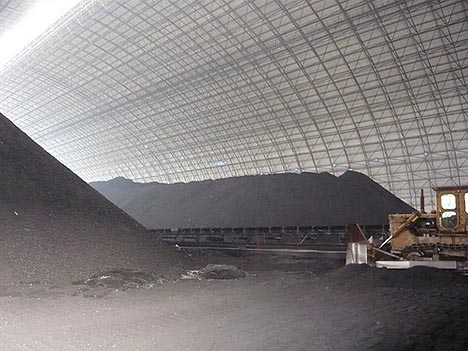
The article on TreeHugger is also interesting as it stipulates that intensification of coal extraction in China not only contributed to more CO2 emssions during the last 10 years, but also to the rejection of a lot of thin particles in the air. As a sort of side effect geoengineering technique, guess what? it also contributed to the cooling of the atmosphere...
Tuesday, February 22. 2011
Infographic: Forget China, Who Are Really the World's Worst Carbon Polluters?
Via GOOD
-----
by Ben Jervey
Probably the most common refrain you here from anyone arguing against the United States agreeing to significant emissions reductions is, "what about China and India?" China is, after all, now the world's largest total emitter of carbon dioxide emissions.
But that's not the most important emissions metric we should be focusing on. Per capita carbon emissions is a much more telling statistic. Sure, China emits the most total tons of carbon dioxide, because it also has the largest population. On a per capita basis, even rapidly developing nations like China and India have a long way to go to catch up with long industrialized nations like the United States and those in Western Europe.
Designer Stanford Kay laid the two metrics side by side in a great and revealing infographic on Miller-McCune.
As Kay (who granted us permission to run the graphic here) writes, "it’s clear there is plenty of room for other, smaller countries to reduce their per capita contributions to a problem that threatens all."
Click on the image or this link to open the original PDF from Miller-McCune. Or find more of Kay's information graphic design work on his site.
Personal comment:
... which gives a slightly different image and possibly allows to target different and additionnal reasons for high energy consumption.
Tuesday, August 10. 2010
Plastic is a new material in the Earths ecosystem
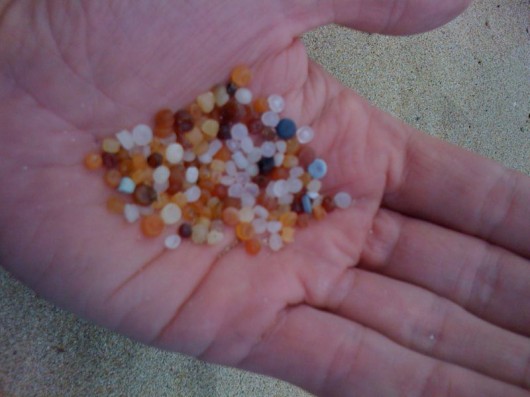
I gathered this hand full of tiny pieces of plastic on less than one square meter of beach in Greece (map). Spotted with the Next Nature Spotter iPhone app.
Related Links:
Wednesday, July 14. 2010
Offshore Oil Strike for All the Family
 [Image: Offshore Oil Strike by BP; photo by BLDGBLOG].
[Image: Offshore Oil Strike by BP; photo by BLDGBLOG].One of the most extraordinary—and timely—subcollections in the archives of the Canadian Centre for Architecture can be found resting on a few metal shelves in the basement, where you will discover stacks of old, oil exploration-themed board games.
Cartel: The International Oil Game.
La Conquête du Pétrole.
King Oil: Combine Luck and Strategy to Control the Oil Fields.
Oil: The Slickest Game in Town.
Total Depth: An Oil Man's Game.
There's even the confident one-word title of Gusher, with no description or subtitle needed—or, if none of those strikes your fancy, you can always play a few rounds of Gas Crisis. Its goals include an exhortation to "Master the Minicar" and "Shun the Sheikhs," showing that smaller cars (and better gas mileage) have been seen as tools of foreign policy since at least the 1970s, when many of these games were first released.
But the one game that seems particularly delirious, a kind of sad joke now, or unfortunate coincidence, is Offshore Oil Strike, "Designed and Manufactured by Printbox (Scotland) Limited in collaboration with The British Petroleum Company Limited." Offshore Oil Strike, brought to you by BP.

 [Images: Offshore Oil Strike by BP; photos by BLDGBLOG].
[Images: Offshore Oil Strike by BP; photos by BLDGBLOG].With this "exciting board game for all the family," released in 1970, BP delivered all "the thrills of drilling, the hazards and rewards as you bring in your own..."
Bring in your own "Offshore Petro-Dollars," that is.
 [Image: Offshore Oil Strike by BP; photo by BLDGBLOG].
[Image: Offshore Oil Strike by BP; photo by BLDGBLOG].The game's internal monetary supply comes in denominations of $200,000, $500,000, $1,000,000, $2,000,000, $10,000,000, and $20,000,000—which is good because you need to earn a lot of it: "The 1st player to make $120,000,000 cash is regarded as the winner."
After all, it's "a race to find and develop the riches 'neath the seabed," where no deepwater is beyond the horizon of possible drilling.
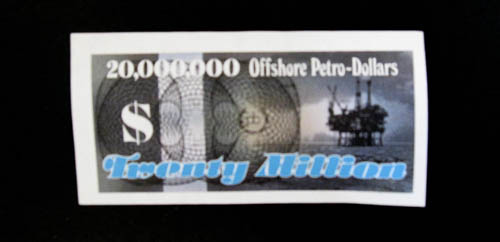
 [Images: Offshore Oil Strike by BP; photos by BLDGBLOG].
[Images: Offshore Oil Strike by BP; photos by BLDGBLOG].Accumulating this fortune, however, is not without its difficulties. Each player has "Hazard" cards to deal with; here are some of the risks BP thought to include:
- —"Accident. Rig shuts down while replacement of key personnel takes place. Miss one turn."
—"Fire breaks out. Pay $2,500,000 for repairs."
—"Hit High-Pressure Gas—Rig Damaged. Specialists called in."
—"Blow-Out! Rig Damaged. Repairs cost $2,000,000"
—"Drill pipe breaks. Pay $500,000 for replacement."
—"Strike High Pressure Gas. Platform Destroyed."
—"Blow-Out! Rig Damaged. Oil Slick Clean-Up costs. Pay $1,000,000."
Players are assigned one of four competing oil company identities, each of which is associated with a specific urban headquarters: Chevron/Rotterdam, Mobil/Dieppe, Amoco/Bergen, and BP/Hull.


 [Images: Offshore Oil Strike by BP; photos by BLDGBLOG].
[Images: Offshore Oil Strike by BP; photos by BLDGBLOG].
As the CCA wrote in their excellent book and exhibition catalog, Sorry, Out of Gas, "Historians and researchers often see games as a source of information about the customs and concerns of a given era. The way games work, their meanings and goals, are linked to the social context in which they are invented and popularized."

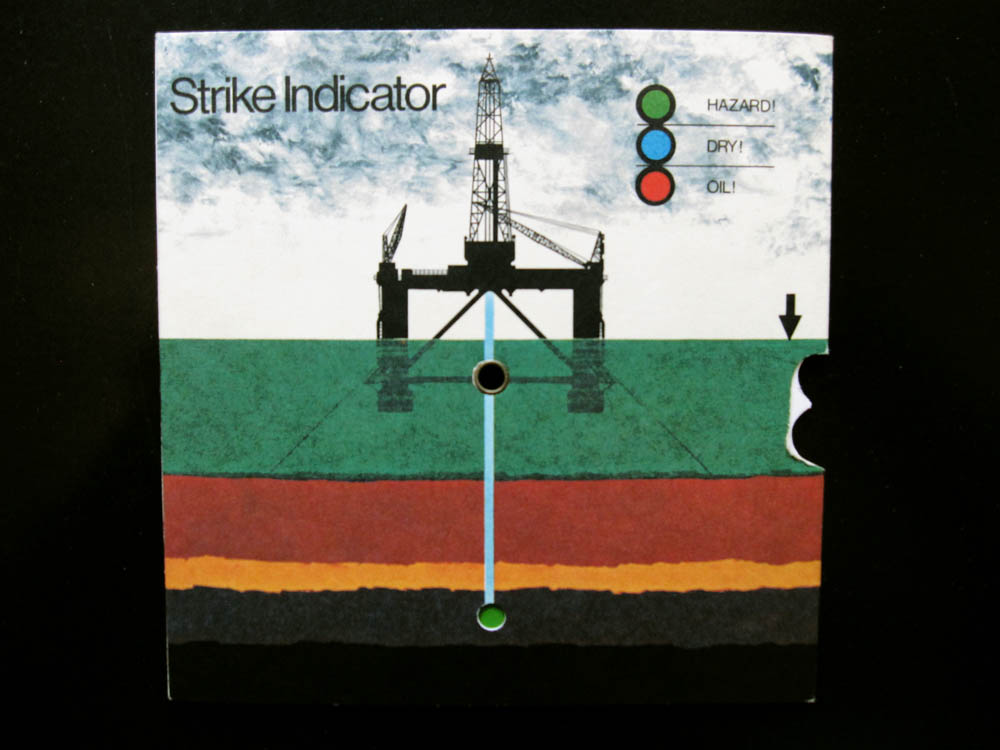 [Images: Offshore Oil Strike by BP; photos by BLDGBLOG].
[Images: Offshore Oil Strike by BP; photos by BLDGBLOG].
I've included several photos of BP's game here so that you can see the space of play for yourself. But perhaps it's time now for BP to release a new edition: Beyond Petroleum: Nightmare Well!, with whole new strategies for hazards and risks, with "Junk Shot" cards and "Top Kill" moves to deploy when needed. Perhaps they could even throw in a few special supplements for good measure: Perpetual Blow-Out! or It'll Take a Clean-Up of $6 Billion to Bring the Gulf Back!




 [Images: Offshore Oil Strike by BP; photos by BLDGBLOG].
[Images: Offshore Oil Strike by BP; photos by BLDGBLOG].
Anderson Cooper and Joe Barton could play a few rounds on national TV.
Friday, July 09. 2010
How Far the Oil Could Spread in a Year
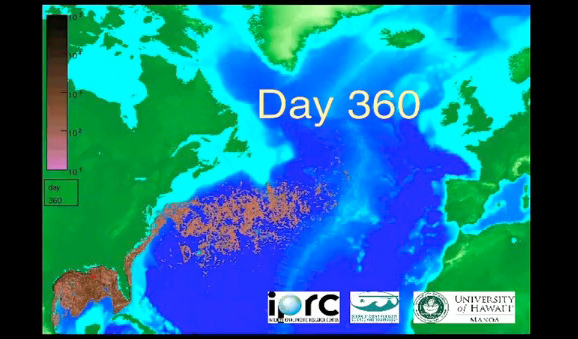
This scary simulation from the School of Ocean and Earth Science and Technology at the university of University of Hawaii shows how far the oil will spread if the Deepwater Horizon spills for a year 150 days worth of spilled oil isn't contained for a year. I'm not sure if this takes into account the oil BP is capturing or not but the point is: Let's get this contained.
Via BLDGBLG
Personal comment:
Nobody speaks about it that much anymore, don't they? (at least here in Europe). The headline time is over, thanks to what? football?
So lets reblog and reblog so that BP continue to feel a bit the pressure (the one from the public opinion, not the one from missed drillings to save their own money).
Pollution-Eating Concrete to Save Your Lungs
Via GOOD
-----
 Researchers in the Netherlands have recently tested a special type of concrete that has the potential to absorb nitrogen oxides, which are a much more potent greenhouse gas than carbon dioxide. If implemented, this concrete could cut down on the the smog and acid rain caused by car exhaust. As Treehugger reports:
Researchers in the Netherlands have recently tested a special type of concrete that has the potential to absorb nitrogen oxides, which are a much more potent greenhouse gas than carbon dioxide. If implemented, this concrete could cut down on the the smog and acid rain caused by car exhaust. As Treehugger reports:
We already knew it worked in the lab, but this was a real-world test and the results are pretty impressive: a 25 to 45% reduction in oxides of nitrogen (NOx) over the special roads. This could mean that someday our roads and other concrete structures could be used to clean up the air.
This seems like a practical idea, though it is somewhat of a secondary fix that doesn't attack the root causes of pollution. However, if city dwellers decide to walk, rather than drive, on this NOx-hungry concrete, then maybe we're on to something.
Read the Treehugger post here.
fabric | rblg
This blog is the survey website of fabric | ch - studio for architecture, interaction and research.
We curate and reblog articles, researches, writings, exhibitions and projects that we notice and find interesting during our everyday practice and readings.
Most articles concern the intertwined fields of architecture, territory, art, interaction design, thinking and science. From time to time, we also publish documentation about our own work and research, immersed among these related resources and inspirations.
This website is used by fabric | ch as archive, references and resources. It is shared with all those interested in the same topics as we are, in the hope that they will also find valuable references and content in it.
Quicksearch
Categories
Calendar
|
|
July '25 | |||||
| Mon | Tue | Wed | Thu | Fri | Sat | Sun |
| 1 | 2 | 3 | 4 | 5 | 6 | |
| 7 | 8 | 9 | 10 | 11 | 12 | 13 |
| 14 | 15 | 16 | 17 | 18 | 19 | 20 |
| 21 | 22 | 23 | 24 | 25 | 26 | 27 |
| 28 | 29 | 30 | 31 | |||

